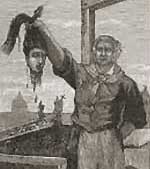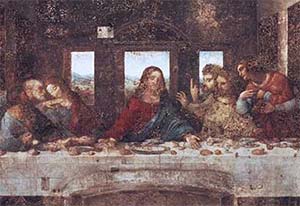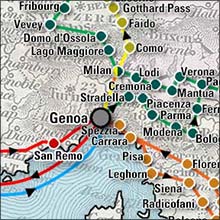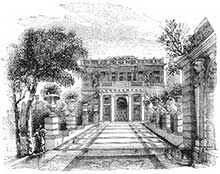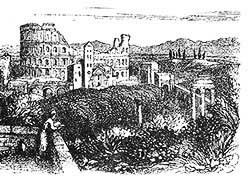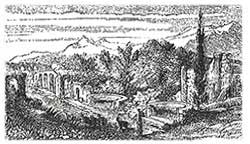Charles Dickens'
Pictures from Italy
Charles Dickens in Italy, 1844-45
Pictures from Italy - Originally published in parts in the Daily News from January to March 1846. Published in one volume in May 1846
Illustrations | Buy it at Amazon.comCharles Dickens, his wife Catherine, her sister Georgina, and the Dickens' five children, along with several servants and "the brave courier", Louis Roche, left London on July 2, 1844 in a large coach bound for Italy (Ackroyd, 1990, p. 433).
On the advice of a friend Dickens had rented a house outside Genoa in Albaro which proved to be unsatisfactory. After three months the family moved to Genoa and into the beautiful Palazzo Peschiere (Slater, 2009, p. 227). Dickens became enchanted with Italy and the manner of the people which he described as "exceedingly animated and pantomimic; so that two friends of the lower class conversing pleasantly in the street, always seem on the eve of stabbing each other forthwith. And a stranger is immensely astonished at their not doing it" (Forster, 1899, v. 1, p. 363).
Early during their one-year stay in Genoa Dickens wrote the Christmas book The Chimes, getting the idea for the title from the incessant ringing of bells in Genoa. On completion of the book he dashed back to England, by way of Venice, Milan (where he reported that clumsy attempts by 'bunglers' to patch Da Vinci's The Last Supper had virtually destroyed it), and Switzerland, to read it to friends. He returned to his family in Genoa just before Christmas 1844 (Slater, 2009, p. 230-231).
Early in 1845 Dickens and Kate left the children with Georgina and traveled through southern Italy visiting Pisa with its leaning tower ("like most things connected in their first associations with school-books and school-times, it was too small" (Pictures from Italy, p. 357)). Initially disappointed with Rome, which he reported looking, at a distance, like London (Pictures from Italy, p. 364), he was soon captivated by the ruins. He reported to his friend John Forster that he had never in his life been so moved or overcome by any sight as by that of the Coliseum, except perhaps by the Falls of Niagara (Forster, 1899, v. 1, p. 414). They visited the ruins of Herculaneum and Pompeii (Pictures from Italy, p. 415), made a very dangerous trip to the top of Vesuvius, even climbing to the very rim and peering into the "Hell of boiling fire below" and coming away with his clothes alight in half-a-dozen places (Pictures from Italy, p. 420-421).
Coming back to Rome to observe Pope Gregory XVI conduct Holy Week, Dickens could not hide his disdain for the Catholic Church whose empty rituals seem to him a farce (Johnson, 1952, p. 553). This anti-Catholic slant found its way into Pictures From Italy to the point that his friend, artist Clarkson Stanfield, who had agreed to illustrate the book, later refused (Slater, 2009, p. 249).The family returned from Italy in June of 1845 (Forster, 1899, v. 1, p. 425). Initially Dickens published reports of his journey in the Daily News as a series of eight "Travelling Letters." Pictures From Italy was published in book form in May 1846 with four woodcuts by Samuel Palmer (Johnson, 1952, p. 589).
The Coach
John Forster reports on Dickens' purchasing a coach for the journey:
The preparation for departure was now actively going forward, and especially his enquiries for two important adjuncts thereto, a courier and a carriage. As to the latter it occurred to him that he might perhaps get for little money "some good old shabby devil of a coach--one of those vast phantoms that hide themselves in a corner of the Pantechnicon;" and exactly such a one he found there; sitting himself inside it, a perfect Sentimental Traveller, while the managing man told him its history. "As for comfort--let me see--it is about the size of your library; with night-lamps and day-lamps and pockets and imperials and leathern cellars, and the most extraordinary contrivances. Joking apart, it is a wonderful machine. And when you see it (if you do see it) you will roar at it first, and will then proclaim it to be 'perfectly brilliant, my dear fellow.'" It was marked sixty pounds; he got it for five-and-forty; and my own emotions respecting it he had described by anticipation quite correctly. In finding a courier he was even more fortunate (Forster, 1899, v. 1, p. 357).
Louis Roche
The Brave Courier
A native of Avignon, France, Louis Roche accompanied the Dickens family to Italy in 1844-45 and then to Switzerland in 1846. Dubbed "The Brave Courier" he proved faithful and resourceful and Dickens continually praised him in both Pictures from Italy and in private letters to Forster:
"The brave C continues to be a prodigy. He puts out my clothes at every inn as if I were going to stay there twelve months; calls me to the instant every morning; lights the fire before I get up; gets hold of roast fowls and produces them in coaches at a distance from all other help, in hungry moments; and is invaluable to me" (Forster, 1899, v. 1, p. 404).
Sadly, Forster also discloses:
[He] justified to the close his master's high opinion. He was again engaged for nearly a year in Switzerland, and soon after, poor fellow, though with a jovial robustness of look and breadth of chest that promised unusual length of days, was killed by heart-disease [in 1849] (Forster, 1899, v. 1, p. 404).
- Sketches by Boz |
- Pickwick |
- Oliver Twist |
- Nickleby |
- Old Curiosity Shop |
- Barnaby Rudge |
- Chuzzlewit |
- Christmas Carol |
- Christmas Books |
- American Notes |
- Pictures from Italy |
- Dombey and Son |
- Copperfield |
- Bleak House |
- Hard Times |
- Little Dorrit |
- Tale of Two Cities |
- Great Expectations |
- Our Mutual Friend |
- Edwin Drood |
- Minor Works |
- The Uncommercial Traveller |
- Short Stories

